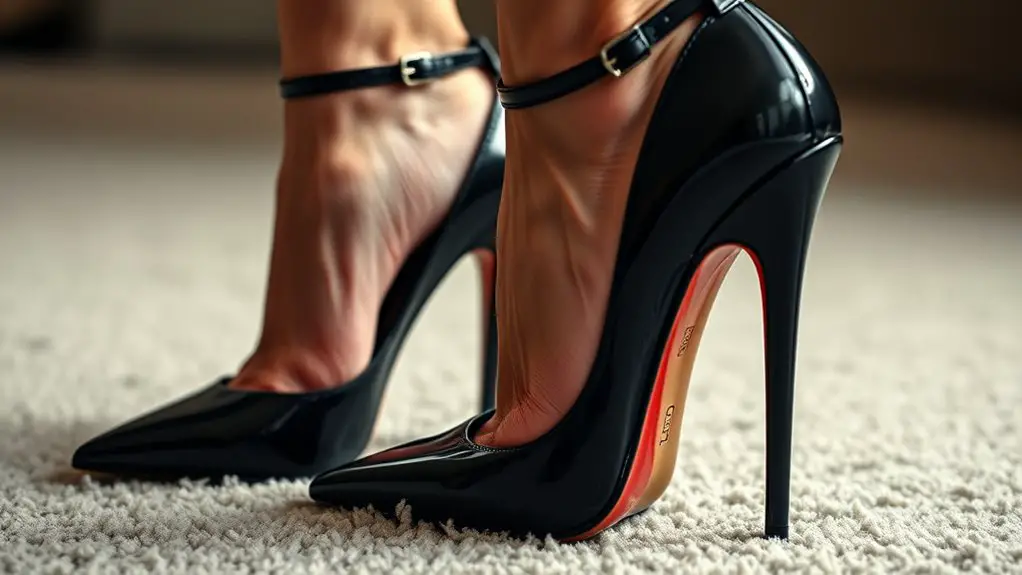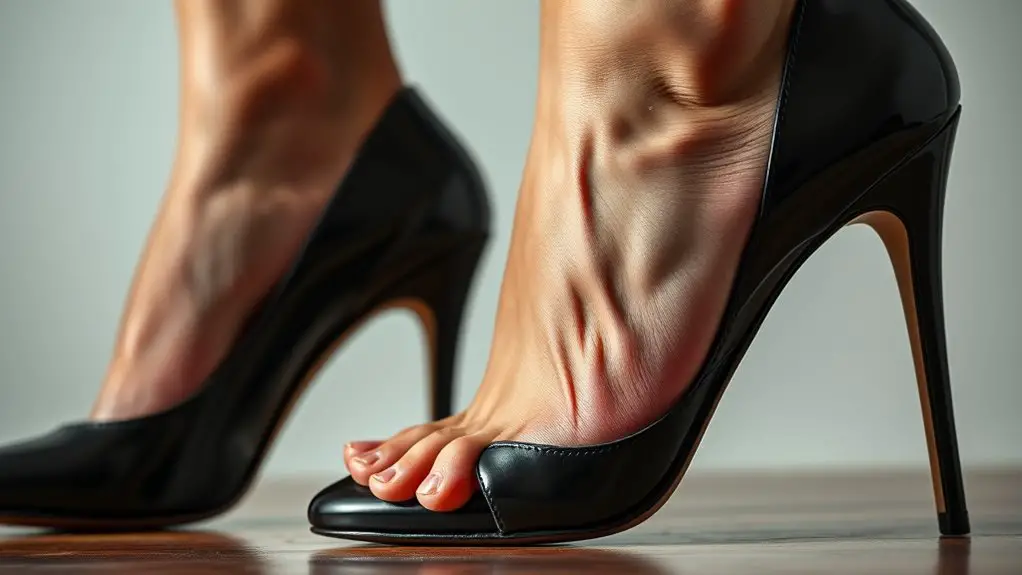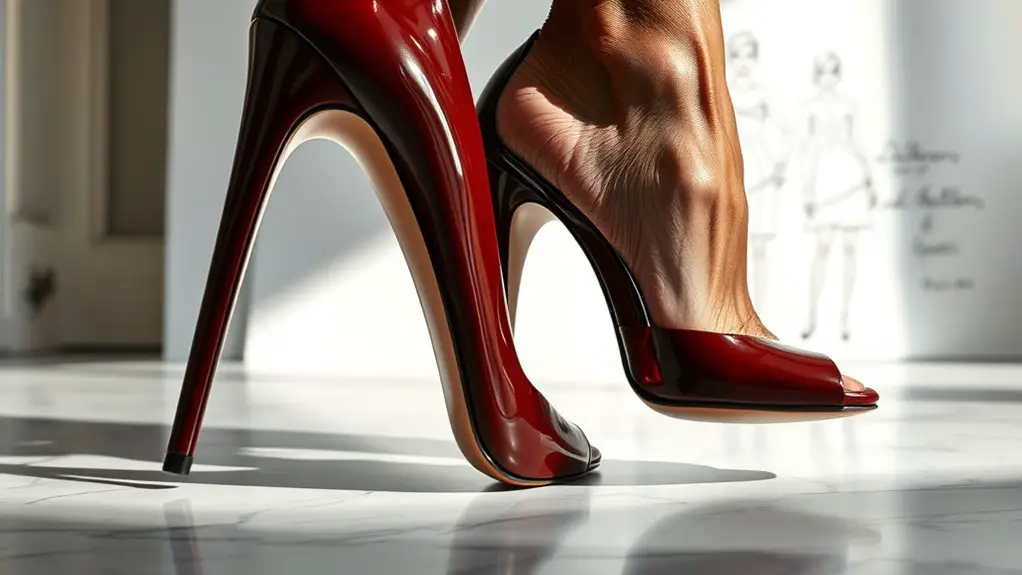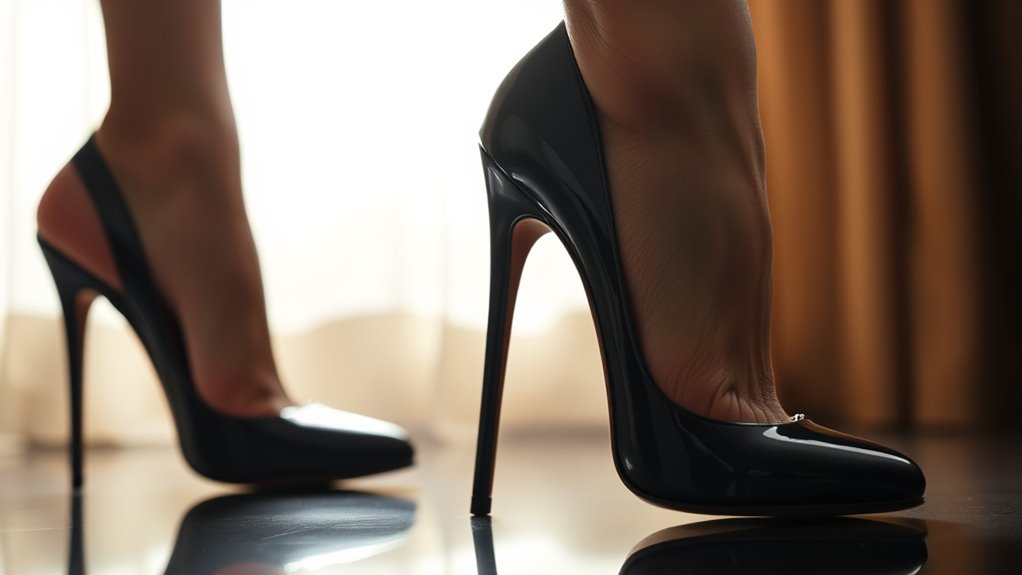Wearing extremely high heels alters your foot mechanics by shifting your center of gravity and redistributing weight. This places excessive pressure on the forefoot, leading to discomfort and strain on muscles and joints. Over time, this can cause common ailments like bunions and plantar fasciitis due to unnatural foot alignment. Restricted ankle motion reduces stability and increases fatigue. Understanding these impacts can help in choosing more comfortable footwear that may prevent pain. More insights on alternatives are ahead.
The Anatomy of High Heels

High heels are designed with a specific structure that directly influences how they affect your feet. The anatomy of high heels includes various components, such as the upper, insole, outsole, and heel. These elements are often constructed from different high heel materials, including leather, synthetic fabrics, and rubber, each impacting comfort and durability.
Heel height variations range from modest to extreme, affecting weight distribution and posture. For instance, a 2-inch heel may provide slight elevation, while a 5-inch heel greatly alters your foot’s alignment. The incline created by the heel height can lead to increased pressure on the forefoot, potentially resulting in pain and discomfort.
Understanding the anatomy of high heels helps you make informed choices. Selecting the right materials and considering heel height variations can mitigate discomfort and enhance your overall experience while wearing them.
The Impact of Heel Height on Foot Mechanics
When you wear heels, the height markedly alters your foot mechanics, affecting your posture and weight distribution. Elevated heels modify heel biomechanics by shifting your center of gravity forward. This change can lead to improper foot alignment, causing your body to compensate in ways that strain your muscles and joints.
As your heels rise, the natural arch of your foot is exaggerated, which may result in increased pressure on the forefoot and diminished shock absorption. This misalignment can lead to a cascade of issues, including altered gait patterns and potential injuries. The ankle’s range of motion is also restricted, which further compromises stability and balance.
Ultimately, high heel wearers may experience increased fatigue and discomfort due to these mechanical changes. Understanding how heel height impacts foot mechanics is essential for making informed decisions about footwear and maintaining long-term foot health.
Pressure Points: How High Heels Distribute Weight

As you slip on a pair of high heels, the distribution of your body weight shifts dramatically, concentrating pressure on specific areas of your feet. This altered weight distribution can lead to discomfort, as your body’s natural alignment changes. Primarily, the forefoot bears most of the weight, resulting in increased pressure at the ball of your foot. Understanding these pressure points is essential for finding pressure relief.
| Pressure Point | Weight Distribution (%) | Possible Relief Strategies |
|---|---|---|
| Ball of the Foot | 70% | Cushioned insoles |
| Arch | 15% | Arch support |
| Heel | 15% | Shock-absorbing heels |
Common Foot Ailments Associated With High Heels
Wearing high heels can lead to a variety of foot ailments that may arise from the unnatural positioning and excessive pressure these shoes create. One common issue is bunions formation, which occurs when the big toe is pushed toward the other toes, causing a painful bony bump on the foot. This is exacerbated by the narrow toe box of high heels, which can force your toes into an unnatural alignment.
Another prevalent ailment is plantar fasciitis, characterized by inflammation of the plantar fascia, the tissue connecting the heel to the toes. The arch of your foot may experience excessive strain while wearing high heels, leading to sharp heel pain, especially after prolonged periods of standing or walking. These conditions highlight the importance of considering foot health when choosing footwear, as neglecting these issues can result in chronic pain and mobility problems.
The Role of Footwear Design in Discomfort

Although high heels are often associated with style and elegance, their design greatly contributes to discomfort and foot pain. The footwear materials used in high heels often lack flexibility, leading to restricted movement and increased pressure on specific areas of your feet. Rigid materials can exacerbate pain by failing to accommodate the natural shape of your foot.
Moreover, design aesthetics often prioritize height and visual appeal over functionality. Elevated heels shift your body weight forward, altering your foot’s alignment and increasing strain on the forefoot. The narrow toe box, a common feature in high heel design, compresses your toes, which can lead to conditions like bunions and neuromas.
The Connection Between Posture and Pain
When high heels elevate your stature, they can markedly alter your posture, leading to a cascade of pain throughout the body. The elevated position shifts your center of gravity, disrupting your natural posture alignment. This misalignment forces your muscles and joints to compensate, often resulting in discomfort in the feet, knees, and lower back.
As your weight distribution changes, the pressure is unevenly distributed across your feet. This can exacerbate existing conditions or create new issues, such as plantar fasciitis or metatarsalgia. Additionally, prolonged wear of high heels can lead to muscle imbalances, further complicating posture alignment.
You may not realize how significant these changes are until pain manifests. Understanding the connection between your footwear choices and posture can be essential for maintaining overall musculoskeletal health. Prioritizing supportive footwear can help mitigate these risks, allowing for better alignment and weight distribution.
Long-Term Effects of Wearing High Heels
Wearing high heels consistently can lead to significant structural changes in your feet, including altered arch shape and toe deformities. Over time, this footwear choice may also result in increased strain on your joints and muscles, contributing to chronic pain and discomfort. Understanding these long-term effects is essential for making informed decisions about your footwear.
Structural Foot Changes
High heels may enhance your appearance, but their long-term use can lead to significant structural changes in your feet. Prolonged wearing of high heels alters foot development, as the elevated position forces your toes into a cramped space. This compression can result in conditions like hammertoe and bunions, which signify underlying structural changes. Over time, the arch of your foot may also flatten, contributing to misalignment and instability. These changes can compromise your foot’s natural biomechanics, leading to an increased risk of injury. By understanding these potential structural alterations, you can make informed choices about your footwear, prioritizing both aesthetics and foot health in your daily life.
Joint and Muscle Strain
The structural changes caused by high heels extend beyond the feet, leading to significant joint and muscle strain in the lower extremities. When you wear high heels regularly, you may experience decreased joint mobility and increased muscle fatigue. This strain can affect your knees, hips, and lower back, resulting in long-term discomfort.
Consider these factors:
- Altered gait: Wearing high heels changes your walking pattern, putting extra stress on joints.
- Muscle imbalances: High heels can lead to tight calf muscles and weakened ankle stability.
- Increased injury risk: Over time, this strain may lead to chronic pain or injuries, such as tendonitis.
Addressing these issues early is essential for maintaining mobility and comfort in the long run.
Alternatives to High Heels for Style and Comfort
While many appreciate the elegance of high heels, alternatives exist that balance style and comfort without sacrificing aesthetics. Stylish flats can provide a polished look while offering better foot support. Comfort sneakers combine trendy designs with cushioning, making them ideal for casual outings. For a more formal setting, dressy loafers are a sophisticated choice that maintains a classic appearance. Elegant ankle boots can elevate your outfit while providing stability and warmth, especially in cooler weather. If you prefer a slight lift, chic block heels distribute weight evenly, reducing strain on your feet. Casual mules offer ease of wear and can be dressed up or down, depending on the occasion. Finally, fashionable sandals can keep you cool while adding a stylish touch to your summer wardrobe. These alternatives guarantee you look good without compromising on comfort, making them excellent choices for everyday wear.
Tips for Reducing Pain While Wearing Heels
Wearing heels doesn’t have to mean enduring pain; there are several strategies to minimize discomfort. Implementing these tips can lead to effective pain relief and a more enjoyable experience in your favorite footwear.
- Choose the Right Fit: Guarantee your heels fit snugly but not too tight. A proper fit reduces pressure points and discomfort.
- Opt for Cushioned Insoles: Invest in high-quality insoles designed for heels. They can absorb shock and provide additional support.
- Limit Heel Height: Whenever possible, select lower heels or consider heel alternatives. Lower heights distribute weight more evenly and reduce strain on your feet.
When to Seek Professional Help for Foot Pain
How do you know when foot pain warrants a visit to a healthcare professional? It’s essential to pay attention to signs of discomfort that persist beyond a few days. If you experience sharp pain, swelling, or bruising, especially after wearing high heels, it’s time to seek medical advice. Additionally, if your pain interferes with daily activities or worsens over time, don’t hesitate to consult a specialist.
Other indicators that you should seek help include numbness or tingling in your feet, difficulty walking, or any changes in the appearance of your feet. These symptoms may signal underlying conditions that require professional evaluation. Remember, early intervention can prevent further complications and improve your overall foot health. Prioritize your well-being by monitoring your symptoms and acting promptly when necessary. Your feet deserve attention, especially when high heels are involved.
Frequently Asked Questions
Can High Heels Affect My Overall Body Alignment?
Studies show 70% of women experience foot issues from high heels. These shoes can alter your foot posture, leading to improper body mechanics and misalignment, ultimately affecting your overall body alignment and increasing discomfort.
Are There Specific Exercises to Strengthen Feet for High Heel Wearers?
Yes, specific exercises like toe stretches and calf raises can strengthen your feet. Incorporating arch support into your footwear can also improve stability and reduce discomfort, enhancing your ability to wear high heels comfortably.
How Do Different Materials in Heels Impact Foot Comfort?
Did you know that 80% of women experience discomfort in heels? The material greatly affects foot comfort; leather typically provides better cushioning impact, reducing pressure points compared to synthetic alternatives, enhancing overall wearability and support for your feet.
Is There a Correlation Between Heel Height and Ankle Injuries?
Yes, there’s a correlation between heel height and ankle injuries. As heel height increases, ankle stability decreases, heightening the risk of sprains and other injuries due to compromised support and balance during movement.
Do High Heels Influence the Development of Bunions or Hammertoes?
Wearing high heels is like walking on a tightrope; it’s precarious. They can contribute to bunion causes and promote hammertoes if worn frequently. Regularly choosing supportive footwear aids in prevention of these painful conditions.



